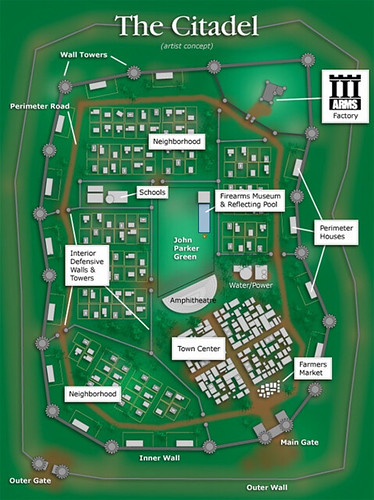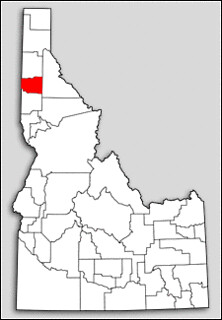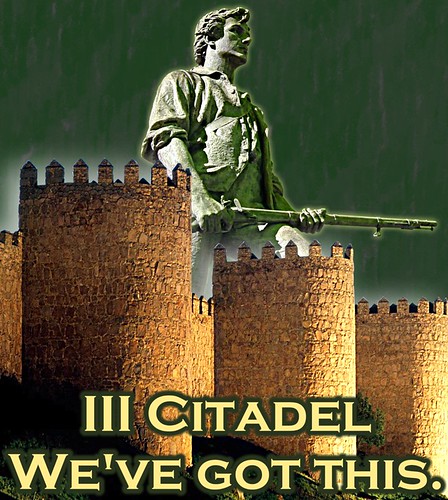Culture clash, or culture convergence? Rightist survivalism meets green urbanism

Posted January 28, 2013 at 1:00PM
There is a very interesting and highly idealistic planned community in the works in northern Idaho. It is contemplated for about 3,500-7,000 families on two to three thousand acres, including commercial, civic and green space. It won’t have the highly urban density of, say, Greenwich Village (this is rural Idaho), but when the net residential acreage is calculated it will definitely be walkable. It is very much designed to be. The new town “is not your typical planned community where the developer's objective is selling cookie-cutter homes at the highest possible profit-margin,” says the project’s website.
It will have multiple car-free zones, especially in residential areas, where families will enjoy a shared commons from their front doors. Neighborhoods will be mixed-income, with affordable housing integrated into all of them ("We want to break the class barriers,” says a prominent project supporter). It will have community gardens, a farmers’ market and a strong emphasis on localism: national chain stores will be forbidden or discouraged, local crafts will be encouraged and mentored through apprenticeships. There will be a small-business incubator.
The idea is to be not only a true community but also locally self-sufficient and resilient, including with respect to energy, where the planners hope to produce more than they consume.  It will have a non-denominational spiritual center, as Jonathan Rose, Chuck Perry and Peter Calthorpe incorporated into the smart growth icon Highlands’ Garden Village in Denver. There’s even a de facto growth boundary contemplated in the working comprehensive plan.
It will have a non-denominational spiritual center, as Jonathan Rose, Chuck Perry and Peter Calthorpe incorporated into the smart growth icon Highlands’ Garden Village in Denver. There’s even a de facto growth boundary contemplated in the working comprehensive plan.
The emphasis on the public realm is strong: “People spend too much time in their back yards,” says a supporter. "When I visit friends in a cul-de-sac neighborhood, everybody is playing in the street.” This community is nothing if not highly aspirational and a clear departure from the run-of-the-mill sprawl that has so crippled America in recent decades. In so many ways, it has the hallmarks of a textbook sustainable community.
Pretty cool, huh?
But, wait – there’s more, and it might affect how many readers of the websites that publish my work might consider this project.
There are a few (not many, truthfully) aspects of green urbanism missing. Everybody who knows my work knows that I am not a fan of so-called “new towns” plopped into previously rural areas. And, for this project, the highly important concept of connectivity – at least in the sense of providing multiple, easy connections to the external surroundings, is not exactly a strong point. This will be a walled and highly fortified city:
“The Towers and Curtain Wall providing the town's primary perimeter defense will be inaccessible to tourists. Each Tower will house condos. The wall sections between Towers will be the location for many of the larger homes . . . Each neighborhood within the walls will have lower defensive walls, dividing the town into defensible sections/neighborhoods. Each neighborhood will have similar housing for visual uniformity and aesthetic appeal.”
 It’s not for nothing that it is called The Citadel. And, while residents of all races and incomes are welcomed, those of all creeds are not:
It’s not for nothing that it is called The Citadel. And, while residents of all races and incomes are welcomed, those of all creeds are not:
“Marxists, Socialists, Liberals, and Establishment Republicans may find that living within our Citadel Community is incompatible with their existing ideology and preferred lifestyles.”
The bold print is from the website, not me.
A proponent of The Citadel project is Glenn Beck, the TV pundit and author who is quite clear about his dislike of planned communities and anything having to do with what he considers code words such as “affordable housing,” “comprehensive plan,” “urban growth boundary,” “open space,” and especially “sustainable community.” Beck believes that those (such as yours truly) who favor these concepts are advancing a hidden United Nations-backed agenda (“Agenda 21”) to displace American sovereignty and freedom. (Beck also has his own planned community in the works, called Independence, USA.)
Funny how the things we say we like don’t seem so likeable when someone we distrust takes them up, and the things our frequent adversaries say they hate don’t seem so bad when they get to design them. My friend Steve Mouzon, who first brought this project to my attention on his The Original Green site, does a great job of pointing out the similarities in concept between the land use principles of The Citadel and those of new urbanism and smart growth.
Most liberally-inclined people (a group that definitely includes myself) will be quite uncomfortable with the community’s strong emphasis on guns and munitions – not just the right to own them, but a duty to own and carry them. Applicants for residence in The Citadel are required to sign a “Patriot Agreement” that includes the following language:
“Two: Every able-bodied Patriot aged 13 and older governed by this Agreement shall annually demonstrate proficiency with the rifle of his/her choice by hitting a man-sized steel target at 100 yards with open sights at the Citadel range. Each Resident shall have 10 shots and must hit the target at least 7 times.
Three: Every able-bodied Patriot aged 13 and older governed by this Agreement shall annually demonstrate proficiency with a handgun of choice by hitting a man-sized steel target at 25 yards with open sights at the Citadel range. Each Resident shall have 10 shots and must hit the target at least 7 times.
Four: Every able-bodied Patriot of age within the Citadel will maintain one AR15 variant in 5.56mm NATO, at least 5 magazines and 1,000 rounds of ammunition. The responsibility for maintaining functional arms and ammunition levels for every member of the household shall fall to the head of household. Every able-bodied Patriot will be responsible for maintaining a Tactical Go Bag or Muster Kit to satisfy the Minuteman concept. Details TBD and posted elsewhere . . .
Eight: All Patriots, who are of age and are not legally restricted from bearing firearms, shall agree to remain armed with a loaded sidearm whenever visiting the Citadel Town Center. Firearm shall be on-the-person and under the control of the Resident, not merely stored in a vehicle.”
A munitions manufacturing enterprise called III Arms is a key component of the project, intended to supply income for The Citadel’s development and upkeep as well as employment for its residents. (Some of The Citadel’s branding and the URL of its website include “III” after the III Percent Patriots.)

The precise location is unsettled as of this writing, though there is a strong preference for Benewah County, Idaho, where the project leaders have bought some initial property for a demonstration project. But the leaders say they will be open to other sites “if Benewah County fails to offer our Citadel Team suitable incentives.”
If you’re intrigued, I recommend a fascinating internal discussion among Steve Mouzon’s (mostly new urbanist, and definitely articulate) readers in the comments to Steve’s blog entry.
(Side note: I’ll confess that, when I first saw a blog title on The Original Green referring to “The Citadel,” I wondered why Steve would be writing about a military school in South Carolina.)
- The Space Between: caring for cities as an expression of faith (October 12, 2012)
- What does 'the pursuit of happiness' mean for communities? (June 29, 2011)
- Warning: black helicopters on the horizon (or so they say) (March 23, 2011)
- Understanding urbanism, from a Christian theologian (March 29, 2011)
- Urbanism in Baghdad: rebuilding Sadr City (February 11, 2010)
- Vive les Bastides – medieval planned communities (February 12, 2008)
- Another lesson from les Bastides (February 13, 2008)
Move your cursor over the images for credit information.
